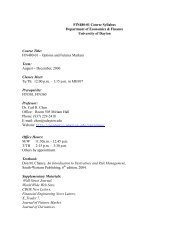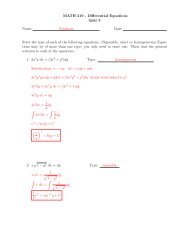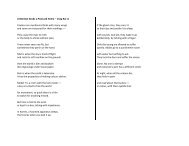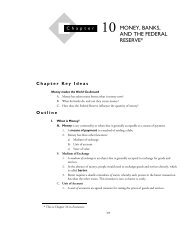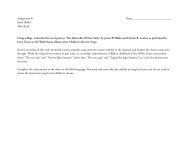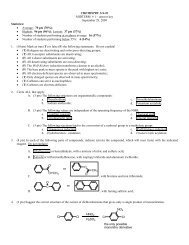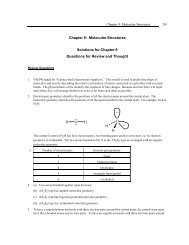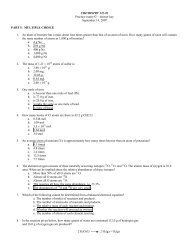Practice Exam 4 2007 Key - University of Dayton Academic Webserver
Practice Exam 4 2007 Key - University of Dayton Academic Webserver
Practice Exam 4 2007 Key - University of Dayton Academic Webserver
You also want an ePaper? Increase the reach of your titles
YUMPU automatically turns print PDFs into web optimized ePapers that Google loves.
. 4°C<br />
c. 6°C<br />
d. 14°C<br />
e. 34°C<br />
10. Suppose a 50.0 g block <strong>of</strong> silver (specific heat = 0.2350 J/g·°C) at 100°C is placed in contact with a 50.0 g block <strong>of</strong> iron<br />
(specific heat = 0.4494 J/g·°C) at 0°C, and the two blocks are insulated from the rest <strong>of</strong> the universe. The final temperature <strong>of</strong><br />
the two blocks.<br />
a. will be higher than 50°C.<br />
b. will be lower than 50°C.<br />
c. will be exactly 50°C.<br />
d. is unrelated to the composition <strong>of</strong> the blocks.<br />
e. cannot be predicted.<br />
11. A 0.1326 g sample <strong>of</strong> magnesium was burned in an oxygen bomb calorimeter. The total heat capacity <strong>of</strong> the calorimeter plus<br />
water was 5,760 J/°C. If the temperature rise <strong>of</strong> the calorimeter with water was 0.570°C, calculate the enthalpy <strong>of</strong> combustion<br />
<strong>of</strong> magnesium.<br />
a. -3280 kJ/mol<br />
b. -24.8 kJ/mol<br />
c. 435 kJ/mol<br />
d. 106 kJ/mol<br />
e. -602 kJ/mol<br />
Mg(s) + 1/2O2(g) → MgO(s)<br />
12. To which one <strong>of</strong> these reactions occurring at 25°C does the symbol [H2SO4(l)] refer?<br />
a. 2H(g) + S(g) + 4O(g) → H2SO4(l)<br />
b. H2(g) + S(g) + 2O2(g) → H2SO4(l)<br />
c. H2SO4(l) → H2(g) + S(s) + 2O2(g)<br />
d. H2SO4(l) → 2H(g) + S(s) + 4O(g)<br />
e. H2(g) + S(s) + 2O2(g) → H2SO4(l)<br />
13. Octane (C8H18) undergoes combustion according to the following thermochemical equation:<br />
2C8H18(l) + 25O2(g) → 16CO2(g) + 18H2O(l) = -11,020 kJ/mol<br />
Given that [CO2(g)] = -393.5 kJ/mol and [H2O(l)] = -285.8 kJ/mol, calculate the standard enthalpy <strong>of</strong> formation <strong>of</strong><br />
octane.<br />
a. -210 kJ/mol<br />
b. -11,230 kJ/mol<br />
c. 22,040 kJ/mol<br />
d. -420 kJ/mol<br />
e. 420 kJ/mol<br />
14. Given 2Al(s) + (3/2)O2(g) → Al2O3(s), = -1,670 kJ/mol for Al2O3 (s).<br />
a. 3,340 kJ/mol<br />
b. 1,670 kJ/mol<br />
c. -3,340 kJ/mol<br />
d. -1,670 kJ/mol<br />
e. -835 kJ/mol<br />
Determine ΔH° for the reaction 2Al2O3(s) → 4Al(s) + 3O2(g)<br />
15. Given the thermochemical equation 2SO2 + O2 → 2SO3, = -198 kJ/mol, what is the standard enthalpy change for the<br />
decomposition <strong>of</strong> one mole <strong>of</strong> SO3?<br />
a. 198 kJ/mol<br />
b. -99 kJ/mol<br />
c. 99 kJ/mol<br />
d. 396 kJ/mol




